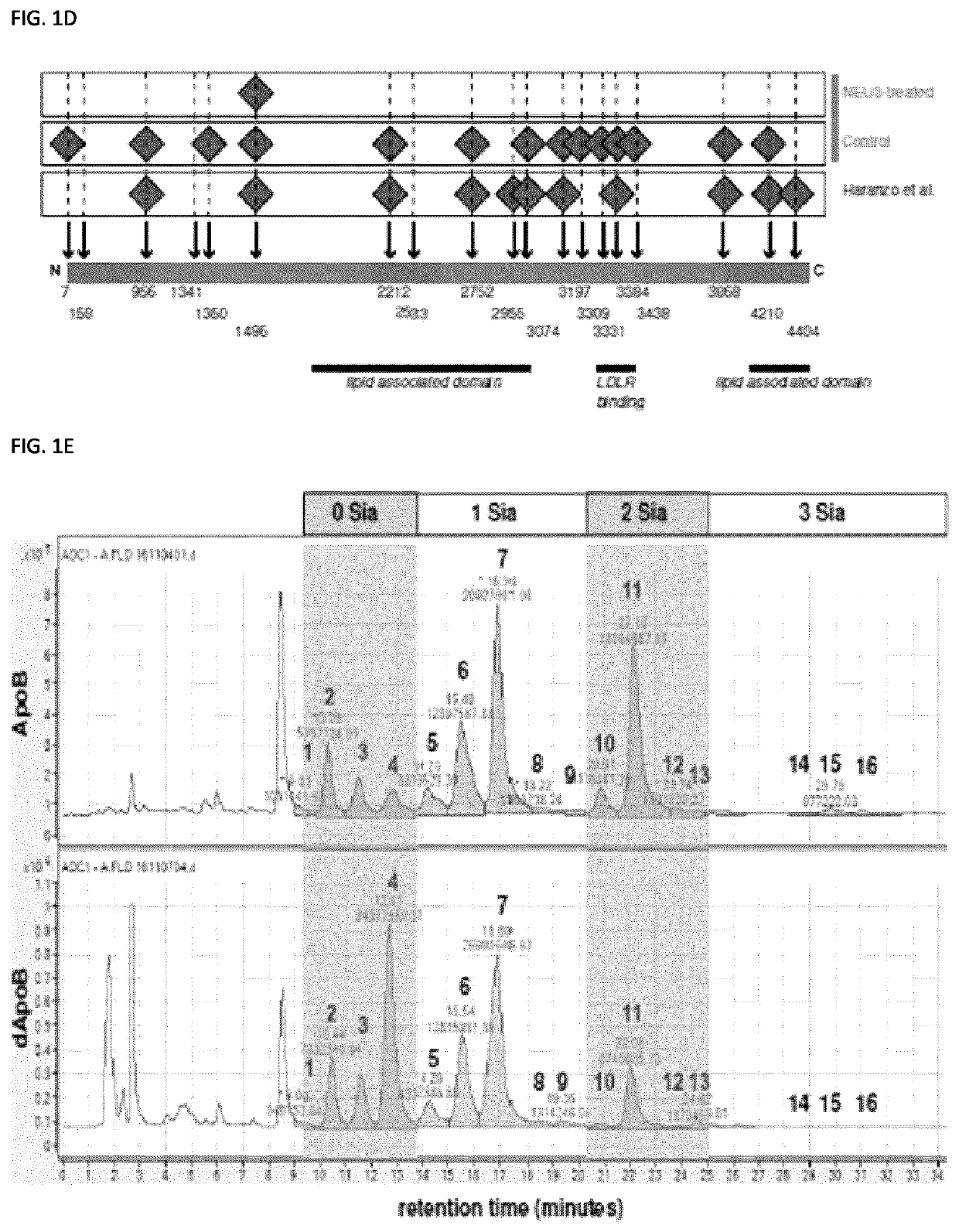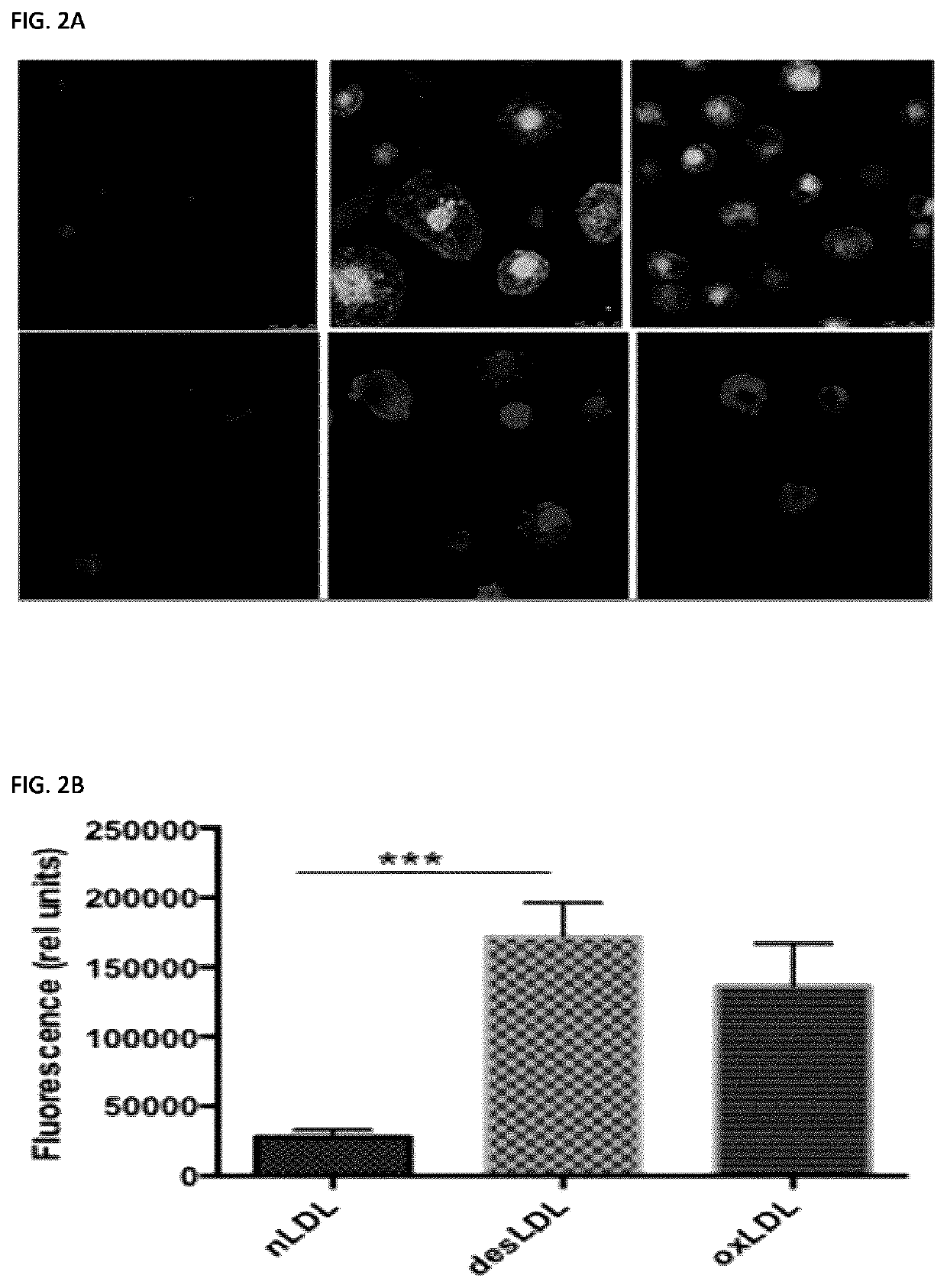Methods of preventing or treating atherosclerosis with inhibitors of specific isoenzymes of human neuraminidase
a technology of human neuraminidase and inhibitors, which is applied in the direction of cardiovascular disorders, drug compositions, organic chemistry, etc., can solve the problems that the cellular, biochemical and molecular mechanisms underlying plaque development are still not fully understood, and achieve the effects of increasing the uptake of human ldl, increasing the accumulation of ldl, and increasing ldl sialylation
- Summary
- Abstract
- Description
- Claims
- Application Information
AI Technical Summary
Benefits of technology
Problems solved by technology
Method used
Image
Examples
example 1
Material and Methods—Biological Isolation of LDL and LPDS
[0468]Low density lipoproteins (LDL) (1.020<d<1.063 g / ml) were isolated from EDTA-anticoagulated blood plasma obtained from healthy normolipidemic human donors by sequential ultracentrifugation as described (Levy, 1990). The isolated LDL fraction was dialyzed against phosphate-buffered saline (PBS) containing 1 mM EDTA at 4° C. Lipoprotein-deficient serum (LPDS) was prepared by ultracentrifugation at density of 1.25 g / ml (Levy, 1990) and dialyzed against PBS at 4° C. Protein concentration was measured using a Bio-Rad™ Bradford reagent.
LDL Modification and Labeling
[0469]Isolated LDL were desialylated by overnight treatment at 37° C. with human recombinant neuraminidases (Smutova, 2014) in a ratio of 1 mU of enzyme per 10 μg of LDL. Before adding the enzyme pH of LDL fraction was adjusted to the pH optimal for the corresponding neuraminidase (4.5 for Neu1, Neu3, and Neu4; and 5.5 for Neu2). Desialylation of LDL was confirmed by ...
example 2
ApoB in Human LDL Can be Desialylated In Vitro by Neuraminidases 3 and 4
[0484]The inventors first tested if human neuraminidases can remove sialic acid residues from ApoB in LDL in vitro. LDL fraction from healthy human subjects was isolated by preparative ultracentrifugation in the density gradient (from 1.019 to 1.063 g / mL) (Steinbrecher, 1987). Purity of the isolated LDL fraction was confirmed by PAGE analysis, which detected a single protein band with a molecular weight of 500 kDa corresponding to that of the major LDL glycoprotein, ApoB. Purified LDL were incubated for 12 h with recombinant human neuraminidases 2, 3 and 4 at the pH corresponding to their pH optimum and the sialylation of ApoB was analyzed by blotting with lectins derived from Sambucus nigra (SNA), and Maackia amurensis (MAL-II), that have affinity to Sia in α-2,6 and α-2,3 linkages, respectively (Shibuya, 1987; Knibbs, 1991) (FIGS. 1A-B). The data showed that incubation of LDL with Neu3 resulted in removal of b...
example 3
Desialylation of LDL Increases their Uptake by Cultured Human Monocyte-Derived Macrophages via Lectin-Dependent Pathway
[0486]To test whether removal of sialic acids from glycan chains of ApoB affects the uptake of LDL by macrophages the inventors compared the uptake of fluorescently labeled native LDL, LDL desialylated by Neu3 treatment (desLDL) or oxidized LDL (oxLDL) by cultured human blood monocyte-derived macrophages. Two types of labels were used, Alexa-fluo, that covalently binds to the ApoB molecule, and Dil (1,1′-dioctadecyl-3,3,3′,3′-tetramethylindocarbocyanine perchlorate), that incorporates into the lipid core of LDL due to its hydrophobicity. Using two types of labeling allowed to analyze simultaneously the uptake of both the LDL particles and cholesterol. Human blood monocytes were purified from the blood of healthy volunteers and differentiated into macrophages by culturing for 7 days in the presence of GM-CSF. To test the uptake, the cells cultured on glass coverslips...
PUM
| Property | Measurement | Unit |
|---|---|---|
| body weight | aaaaa | aaaaa |
| body weight | aaaaa | aaaaa |
| body weight | aaaaa | aaaaa |
Abstract
Description
Claims
Application Information
 Login to View More
Login to View More - R&D
- Intellectual Property
- Life Sciences
- Materials
- Tech Scout
- Unparalleled Data Quality
- Higher Quality Content
- 60% Fewer Hallucinations
Browse by: Latest US Patents, China's latest patents, Technical Efficacy Thesaurus, Application Domain, Technology Topic, Popular Technical Reports.
© 2025 PatSnap. All rights reserved.Legal|Privacy policy|Modern Slavery Act Transparency Statement|Sitemap|About US| Contact US: help@patsnap.com



